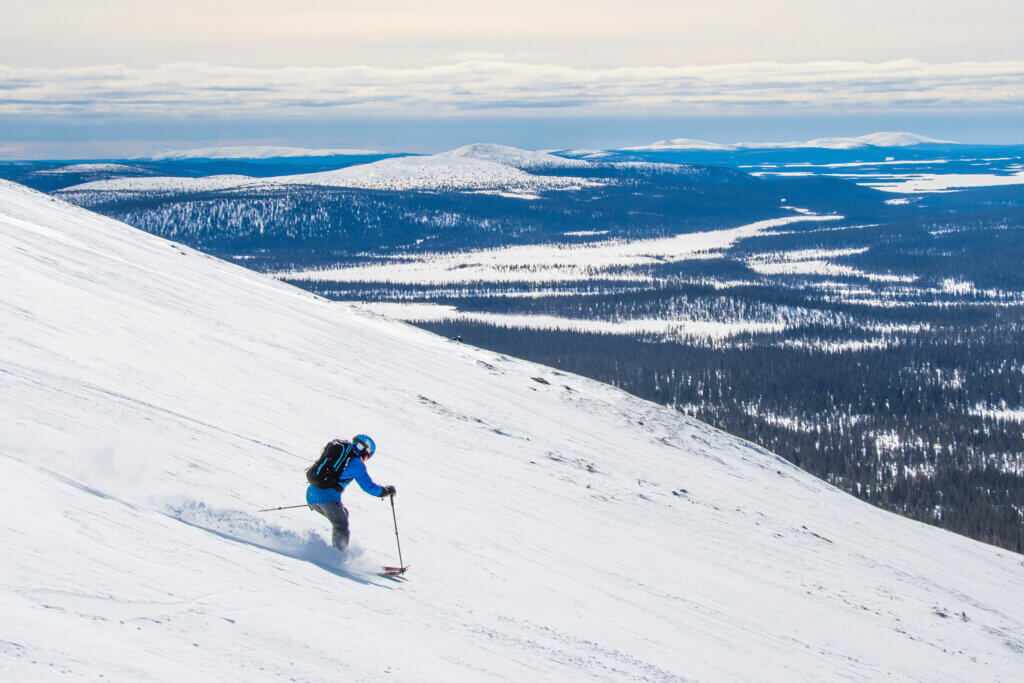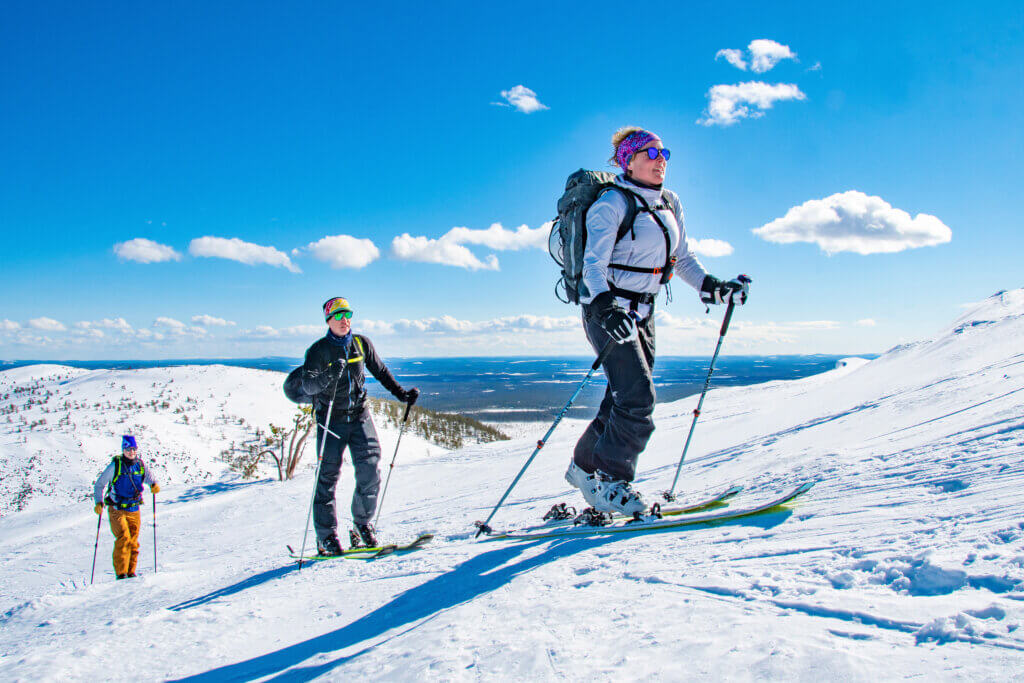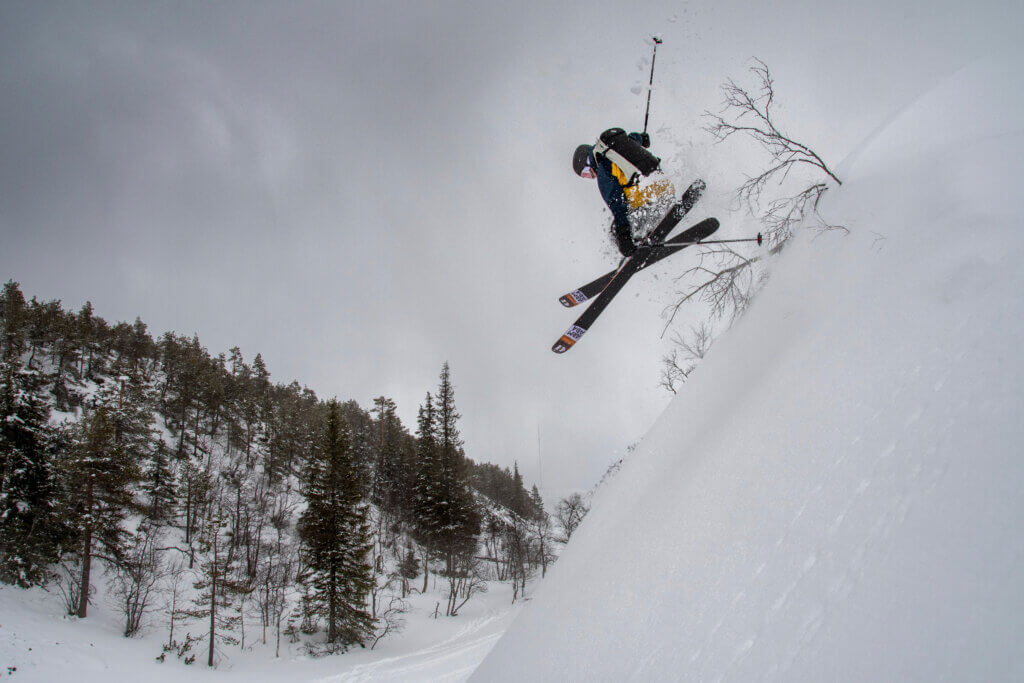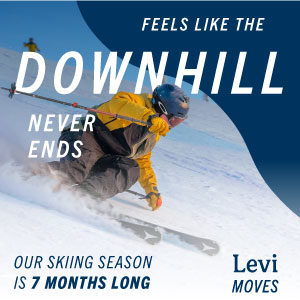National Parks: A Treasure Trove for Skiers
Finland’s national parks offer silent fells, sparkling snow, and dream lines for freeriders. But they’re not ski resorts – they’re protected natural landscapes. Here’s how to enjoy these pristine areas safely, responsibly, and in harmony with nature.

Some of Finland’s finest ski lines are found in national parks. Photo taken in Pyhä-Luosto National Park.
National parks are a treasure for Finnish outdoor enthusiasts – including freeriders. Many of Finland’s best and most popular backcountry ski areas are located in national parks. However, chasing powder should never mean rushing blindly into a park; movement must always respect nature.
“A freerider is a guest in nature,” reminds Erkki “Eki” Ollila. In addition to his civil service work as a Senior Specialist in Outdoor Recreation, Metsähallitus – Parks & Wildlife Finland, Eki has long been a skier. He has taught skiing in Pyhä Ski Resort for over 20 years and leads backcountry trips in the fells. He also represents Metsähallitus in the steering group of the Finlav Avalanche Safety Training program.
In this article, Eki explains how to navigate a national park safely and how skiers can make the most of the park’s treasures.

National Parks as Part of Environmental Education
National parks were created primarily for nature conservation. However, they differ from other protected areas because they are also intended for recreational use. Metsähallitus maintains trails and fire pits, among other facilities, to support visitors’ outdoor activities.
“National parks teach people to value and respect nature. They are also part of environmental education,” Eki explains.
In 1880, explorer A.E. Nordenskiöld initiated the idea of establishing protected areas in Finland. This was early on, considering the world’s first national park – Yellowstone in the USA – was founded in 1872.
Debates about nature as national heritage, a resource for economic growth, and a source of spiritual strength continued for decades until Finland’s first national parks were established in 1938. The first parks, Pallas-Ounastunturi and Pyhätunturi, remain popular among skiers and other outdoor enthusiasts.
“My relationship with nature has developed through national parks. Exploring these areas has deepened my respect for nature. Even though they are my workplace, they are still places of peace,” Eki shares.

Use Everyone’s Rights Wisely
Many of Finland’s best freeride slopes are in national parks. As freeriding grows in popularity, everyone visiting a park must understand their responsibility.
“Freeriders have traditionally been very respectful of nature,” Eki notes.
Skiers rarely cause problems. Occasionally, however, it is forgotten that national parks exist primarily for nature conservation, not just for recreation or play.
“It’s important that the principles of responsible outdoor activity are passed on to new participants and younger generations. Experienced skiers should share this knowledge with newcomers.”
Skiers move differently in a park than most visitors, especially compared to summer hikers. Skiers often leave marked trails to find their lines.
“All parks have their own regulations, which may specify where and how visitors may move. A good example is the Peurakero restriction zone in Pyhä, where access is prohibited from mid-February to the end of May to protect vulnerable wildlife,” Eki reminds.
Restriction zones guide visitors to areas where their presence causes minimal disturbance. Information can be checked on Retkikartta.fi or the Luontoon.fi site.
Even under Everyone’s Rights, freeriders must avoid causing harm. Parks also contain avalanche-prone areas in addition to prime ski lines.

National Parks as Part of a Megatrend
Skiing in national parks has a long tradition. Over the past decade, the number of freeriders seeking pristine lines has grown significantly, and more visitors inevitably bring more disturbances.
Skiers are not the only growing visitor group. Media frequently reports the near-explosive popularity of national parks. Part of this is due to the COVID period, when Finns became more interested in exploring domestic nature. The global outdoor megatrend is also evident in Finland.
Social media further drives visitation. Riisitunturi, famous for its frost-covered trees, is a prime example. Visitor numbers have grown so much that parking at the base is sometimes a problem.
“Social media strongly influences visitors. A hidden, scenic spot can suddenly become a social media hit, attracting unexpected crowds. For example, Oulanka’s Pähkänänkallio became iconic, but without proper infrastructure, the area deteriorated rapidly. A nesting goshawk also lived there, so a restriction zone was established for the breeding season,” Eki explains.
Sharing photos and GPX tracks also requires responsibility: “If you share them, make sure they’re for areas you’re allowed to visit. The more followers you have, the greater the potential impact.”

National Parks Are Not Ski Parks
Despite growing visitor numbers, problems in national parks are limited.
“Most issues occur in summer: illegal fire pits or disregarding forest fire warnings. There is some litter, but surprisingly little considering the number of visitors,” Eki lists.
More visitors also means more maintenance work for Metsähallitus: collecting trash, delivering firewood, and emptying toilets. Structures such as boardwalks and stairs also wear down.
Park visitors can help maintain the park. For example, packing a small trash bag allows you to carry out litter. Generally, do things that reduce the need for maintenance.
“But it’s always better to use toilets than go along the trail!” Eki emphasizes.
Freeriders are traditionally nature lovers and respectful of the environment.
“Now that new participants are entering freeriding from groomed slopes and parks, the tradition of respecting nature should continue. Knowledge should be shared with new riders and future generations to maintain freeriders’ good reputation.”

Skiing in a National Park is an Experience
When asked which ski day stands out most in his memory, Eki reflects briefly before answering confidently:
“The best days were a couple of years ago at Pyhä’s Noitatunturi, when we had great spring snow. The cold overnight hardened the slopes, and the sun during the day created perfect firn conditions for skiing.”
A sunlit, snowy fell slope in nature is always a memorable experience for even the most experienced freerider. Eki’s advice is worth remembering:
“Enjoy the whole experience: nature, peace, and quiet. That’s what most people come for, and what I seek in national parks. Great snow is a bonus.”

Eki’s Checklist for Visiting a National Park
- Review park rules, restriction zones, etc., before your trip. Useful resources include Luontoon.fi, Retkikartta.fi, or the Facebook group “Vapaalaskijat” – the Finnish freeriders’ own Facebook group
- Prepare thoroughly: equipment, gear, route planning, first aid skills, avalanche safety, etc.
- Ski only in permitted areas and respect nature – do not ski over trees.
- Avoid causing unnecessary disturbance.
- Everyone’s Rights provide broad freedom, but always ensure your safety and that of your group. Do not endanger others – e.g., avoid triggering avalanches toward other visitors.
- Pack a small trash bag and carry out your waste.
- Explore guided trips; ski schools in Pallas, Pyhä, and Ylläs offer expertise and guided tours that have been available for many years.
Skiing and snowboarding
11.3.2022
Updated 9.10.2025










